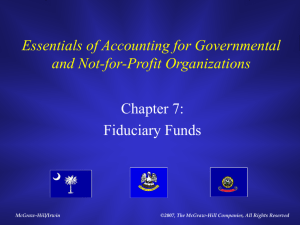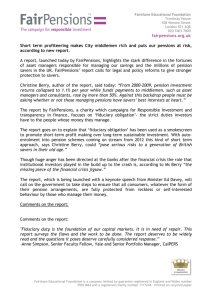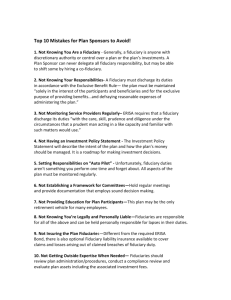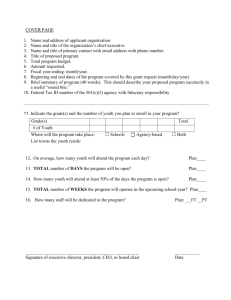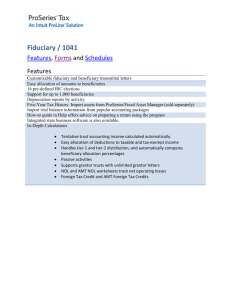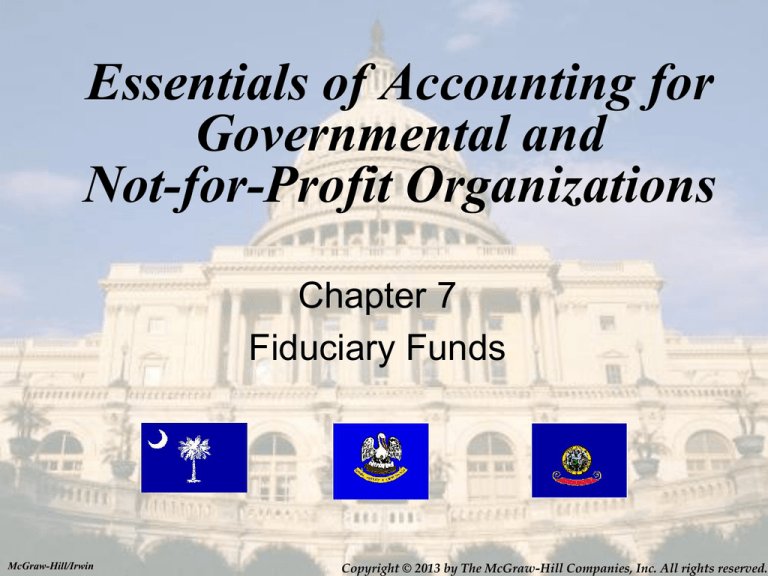
Essentials of Accounting for
Governmental and
Not-for-Profit Organizations
Chapter 7
Fiduciary Funds
McGraw-Hill/Irwin
Copyright © 2013 by The McGraw-Hill Companies, Inc. All rights reserved.
Overview of Chapter 7
Overview of fiduciary funds
Agency funds
Private-purpose trusts
Investment trust funds
Pension (and post-employment benefit)
funds
Re-cap of Fiduciary Fund Financial
Statements
7-2
Overview of Fiduciary Funds
Fiduciary funds report resources which do not
belong to the government but which are being
held by the government as agent or trustee.
As a general rule the accrual basis and
economic resources measurement focus are
used.
Agency funds do not have revenues, expenses or net
assets -- their accounting equation is Assets=Liabilities
pension trusts do not reflect the estimated obligation for
pension and other benefits.
7-3
Fiduciary Funds and the Government-Wide
Financial Statements
Fiduciary assets are NOT included in the
government-wide statements because the
resources are not available for general use
They are reported at the fund level only.
7-4
Fiduciary
Funds are not
included in
governmentwide
7-5
Agents vs. Trustees
The difference in agents and trustees is a
legal distinction concerning the
responsibilities of the fund manager.
Agents hold assets and keep them safe from theft
etc.
Trustees are responsible for not only holding the
assets safely, but also for administering an
investment program to earn a reasonable return on
the principal.
7-6
Common Uses of Agency Funds
Collection of taxes to service special
assessment debt
Used when governments are not legally obligated
to pay the debt in case of default by citizens.
Tax agency fund
When you have property taxes supporting
governments in overlapping geographic areas, one
unit typically agrees to do all of the tax collection
and remit appropriate amounts to other units.
For example, sales taxes are generally collected by the state government.
That portion belonging to cities and counties is recorded in an agency fund
until payment is made to the local governments.
7-7
Accounting Equation
for Agency Funds
Note: The accounting equation is:
Assets = Liability
There are no revenues, expenses, or fund
balances. Closing entries are not necessary.
7-8
Financial Statements for Agency Funds
Agency assets and liabilities will be included in the
Statement of Fiduciary Net Assets(Position).
There are no revenues or expenses so agency funds do
not appear in the Statement of Changes in Fiduciary
Net Assets(Position).
However, the Combining Statement of Changes in Assets
and Liabilities for Agency Funds allows users to see
activity for the year.
7-9
Private Purpose Trust Funds
Used when the government administers funds used for
beneficiaries other than the government and its
citizens. For example, endowment investments providing income to be
used for scholarships.
In some cases the principal is held intact.
These are called endowments or nonexpendable
funds.
In other cases, both the principal and income can be
spent (expended) for specific purposes.
7-10
Private Purpose Trusts vs. Permanent Trusts
Although Permanent and Private Purpose
Trust Funds may appear similar, these two
forms of trust fund have very different
accounting
Permanent Funds use the modified accrual basis
of accounting while Private Purpose Trusts use
the accrual basis.
Permanent Funds are included in the
government-wide financial statements and
Private Purpose Trusts are not.
7-11
Investments in Trust Funds
The primary guidance on reporting
investments is GASB 31
Investments are carried at fair value -usually measured by a quoted market
price
Holding gains and losses are reported as
“Net increase (decrease) in fair value of
investments”
7-12
Reporting of Investment Gains and Losses
Unlike business accounting, the financial
statements are not permitted to distinguish
between realized and unrealized gains and
losses:
Changes in value from completed exchanges
(realized gains or losses), and
Changes from year end adjustments to fair value
for investment balance (unrealized gains or
losses).
7-13
Escheat Property
Escheat Properties are
resources from
unclaimed bank
accounts, estates, etc.
Escheat property is
typically turned over to
the state -- the state
searches for owners.
Typically the state may
keep part of unclaimed
amount and return some
to the local level.
The amount treated as
net revenue to the state
should be the amount
they ultimately expect to
be able to keep.
7-14
Escheat Property - continued
The escheat property should be reported either in
a private-purpose trust fund or in the fund where
the property ultimately escheats.
When the government takes over property, it records the
asset at its FMV and an equal amount of gross
contribution revenue.
The $ amount expected to be distributed to owners should
be estimated and treated as an expense and liability.
7-15
Investment Trust Funds
Internal Investment
Pools
If government money is
pooled for efficient
management, the
individual investment
balances should be
shown on the balance
sheets of the
contributing funds of the
government (not in an
investment trust fund).
External Investment
Pools
These represent amounts
held for other governments
participating in the
investment pool.
External moneys are
reported in investment trust
funds
7-16
Reporting by Investment Trusts
Investment Trust funds use the accrual
basis
Investments are reported at fair value
Both realized and unrealized changes in fair value
are reported as “Net increase (decrease) in fair
value of investments”
Special note disclosures show categories of
investments etc.
7-17
Pensions: Types of Pension Plans
Contributory vs. noncontributory funds -- refers to whether
the ‘employee’ is required to contribute
Defined benefit plans:
The employer must pay a guaranteed level of benefit,
computed using a formula.
The risk of additional future liability is on the employer.
Defined contribution plans:
The employer pays based on assets accumulated with
investment earnings
The risk of insufficient retirement pay is on the employee,
not the employer.
7-18
Pension (and other postemployment benefits)
Trust Financial Statements
Statement of Plan Net Assets(Position)
Assets less short term accrued liabilities = Net
assets(position)
Statement of Changes in Plan Net
Assets(position)
Takes the place of an income statement -- uses
the terms Additions and Deductions instead of
Revenues and Expenses.
7-19
Pension Funds – Additional Disclosures
Required supplementary schedules:
Schedule of Funding Progress
Shows trends over long time period
Schedule of Employer Contributions
Shows difference in what the government is
contributing and what the actuary says should be
contributed - Annual Required Contribution
7-20
Pension Note Disclosures
Descriptions of the pension plan
Accounting policies
Lists of investments which exceed 5% of net assets
The idea is that those investments are more risky because
the portfolio may be insufficiently diversified.
Description of actuarial methods used
7-21
Pensions: Employer Reporting
The previous slides discussed how to
handle pension moneys once they are in
the pension trust, but those money’s have
to be transferred in from an another fund
(i.e. the employer fund)..
In general, the employer fund contribution is
considered a quasi-external transaction.
The amount of the required contribution is an
expenditure in government type funds and an
expense in proprietary types
7-22
IRS 457 Deferred
Compensation Plans
Example of IRS 457 plan: Manager earns
$50,000 but has $5,000 withheld and contributed to a 457
plan …. The manager will not be taxed on the $5,000 until
he draws it out at retirement.
At one time these moneys were to be accounted for in
an agency fund.
Current requirements:
These resources are not shown in government financial
statements if the plan is administered by an external party.
If the government administers or participates in investment
decisions, then a pension trust fund would be used.
7-23
Re-Cap of Fiduciary Fund
Financial Statements
Statement of Fiduciary Net Assets (Statement
of Fiduciary Net Position required after 2013)
Statement of Changes in Fiduciary Net
Assets(position)
Supplemental Schedules
Schedule of Pension Funding Progress
Schedule of Employer Pension Contributions
Again: Fiduciary Funds are NOT included in government-wide statements
7-24

